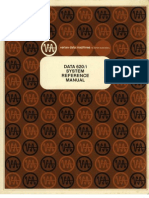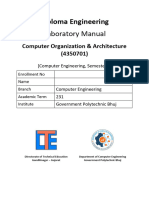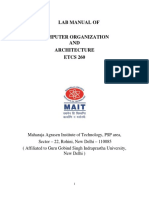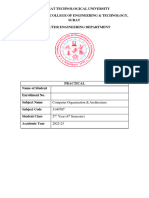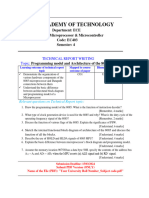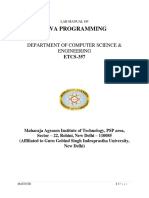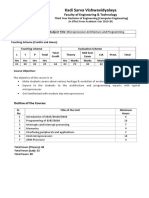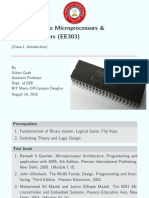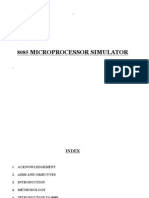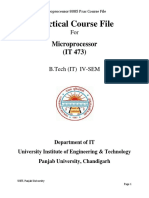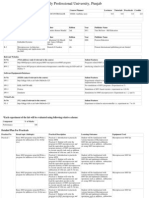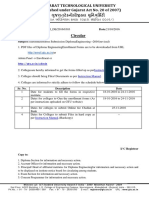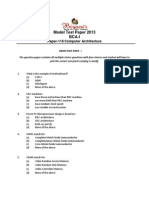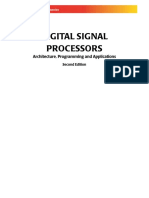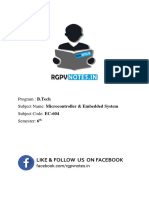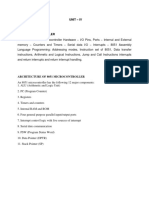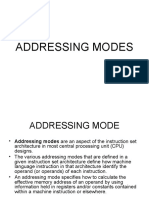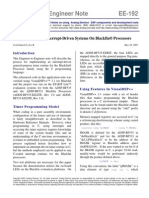3330705
3330705
Uploaded by
Jigar SoniCopyright:
Available Formats
3330705
3330705
Uploaded by
Jigar SoniOriginal Description:
Copyright
Available Formats
Share this document
Did you find this document useful?
Is this content inappropriate?
Copyright:
Available Formats
3330705
3330705
Uploaded by
Jigar SoniCopyright:
Available Formats
Microprocessor and Assembly Language Programming
Course code:3330705
GUJARAT TECHNOLOGICAL UNIVERSITY, AHMEDABAD, GUJARAT
Course Curriculum
MICROPROCESSOR AND ASSEMBLY LANGUAGE PROGRAMMING
(Code: 3330705)
Diploma Programme in which this course is offered
Computer Engineering
1.
Semester in which offered
3rd Semester
RATIONALE
The microprocessor is challenging and very dynamic field. This course explores architecture
of a microprocessor and its programming in assembly language. The student will be able to
apply logics to various given problems and develop programs using assembly language
construct that would help them to develop real time microprocessor based application
programs.
2.
COMPETENCY (Programme Outcome according to NBA Terminology):
The course content should be taught and implemented with the aim to develop different types
of skills so that students are able to acquire following competency:
Develop code, debug, test and execute various assembly language programs using
8085 instruction set.
3.
TEACHING AND EXAMINATION SCHEME
Teaching Scheme
(In Hours)
Total Credits
(L+T+P)
Examination Scheme
Theory Marks
Practical Marks
ESE
PA
ESE
PA
70
30
20
30
Legends: L - Lecture; T - Tutorial/Teacher Guided Student Activity; P - Practical;
Semester Examination; PA - Progressive Assessment
GTU/NITTTR/Bhopal/12-13
Total
Marks
150
C - Credit; ESE - End
Gujarat State
Microprocessor and Assembly Language Programming
4.
Course code:3330705
COURSE DETAILS
Unit
Unit I
Introduction of
Microprocessor
Major Learning Outcomes
(Course Outcomes in
Cognitive Domain according
to NBA terminology)
1a. Classify types of
microprocessor.
1b. Define various buses and
their functions
1c. List the operations of
microprocessor
Topics and Sub-topics
1.1 Evolution of microprocessor and it's types
1.2 Microprocessor Bus organization : Data
Bus, Address Bus and Control Bus
1.3 Operations of microprocessor: internal data
manipulation, microprocessor initiated and
peripheral or external initiated
1.4 Pin diagram and block diagram of 8085
1.5 Architecture of 8085
1.6 Internal registers organization of 8085
1.7 Limitations of 8085
2.1 8085 machine cycle and bus timings to
fetch, decode and execute instruction from
memory
1d. Draw and Explain
microprocessor
architecture.
Unit II
Instruction
Cycle and
Timing Diagram
2a. Explain the bus timing
diagram
2b. Draw machine cycle with
timing diagram
2.2 Memory read and write
2.3 Input/Output read and write cycle with
timing diagram
Unit III
8085 Instruction
set
3a. Interpret machine
language format,
addressing modes and
operations with various
types of instructions
3b. Develop simple programs
3.1 Machine language instruction format :
Single byte, two byte, three byte
instructions
3.2 Various addressing modes
3.3 Data transfer operation and instruction
3.4 Arithmetic operation and instruction
3.5 Logical operation and instruction
3.6 Branch operation and instruction
3.7 Stack operation and instruction
3.8 Input/Output and machine control operation
and instruction
3.9 Simple programs with 8085 instruction
Unit IV
Programming
Techniques of
8085
4a. Develop programs using
control structures
4b. Implement subroutines,
procedures.
4.1. Looping, Counting and indexing
4.2. Counter and Timing delays
4.3. Stack and subroutine basic concepts
4.4. Procedure and macro
Unit V
8085 Interrupts
5a. Classify interrupts and list
its applications
Unit VI
Introduction to
Advanced
6a. Draw block diagram and
6b. Explain 8086
microprocessor
architecture.
5.1 Interrupts and its need
5.2 classification of interrupts
5.3 8085 interrupts: software, hard ware, and
priorities of interrupts
5.4 8085 vectored interrupts:TRAP,INTR
5.5 RST 7.5, RST 6.5, RST 5.5
6.1. Block diagram - Architecture of 8086
6.2. Register organization of 8086
GTU/NITTTR/Bhopal/12-13
Gujarat State
Microprocessor and Assembly Language Programming
Course code:3330705
Major Learning Outcomes
(Course Outcomes in
Cognitive Domain according
to NBA terminology)
6c. Explain instruction
pipelining and memory
segmentation
6d. Differentiate maximum
and minimum mode
operation with diagram
Unit
Microprocessor
Topics and Sub-topics
6.3. Concepts of Instruction pipelining
6.4. Memory segmentation
6.5. Memory address generation
6.6. Minimum and Maximum mode
operation and diagram
5. SUGGESTED SPECIFICATION TABLE WITH HOURS & MARKS (THEORY)
Unit
I
II
III
IV
V
VI
Unit Title
Introduction of Basic
Microprocessor
Instruction Cycle and
Timing Diagram
8085 Instruction set
Programming Techniques
of 8085
8085 Interrupts
Introduction to Advanced
Microprocessor
Total
Teaching
Hours
6
Distribution of Theory Marks
R
U
A
Total
Level
Level
Level
Marks
7
7
0
14
07
12
8
0
0
7
0
7
14
14
14
4
8
0
7
7
7
0
0
07
14
42
14
35
21
70
Legends:R = Remember; U= Understand; A= Apply and above levels (Blooms revised taxonomy)
Note: This specification table shall be treated as a general guideline for students and teachers.
The actual distribution of marks in the question paper may vary slightly from above table.
6.
SUGGESTED LIST OF EXERCISES/PRACTICAL
The practical/exercises should be properly designed and implemented with an attempt to
develop different types of practical skills (Course Outcomes in psychomotor and affective
domain) so that students are able to acquire the competencies (Programme Outcomes).
Following is the list of practical exercises for guidance.
Note: Here only Course Outcomes in psychomotor domain are listed as practical/exercises.
However, if these practical/exercises are completed appropriately, they would also lead to
development of Programme Outcomes/Course Outcomes in affective domain as given in a
common list at the beginning of curriculum document for this programme. Faculty should
refer to that common list and should ensure that students also acquire those Programme
Outcomes/Course Outcomes related to affective domain.
GTU/NITTTR/Bhopal/12-13
Gujarat State
Microprocessor and Assembly Language Programming
7.
Course code:3330705
Sr.
No.
Unit No
Practical/Exercise (Course Outcomes in Psychomotor Domain
according to NBA Terminology)
1
2
I
III
III
III
5
6
III
III
7
8
III
III
9
10
11
12
III
IV
IV
IV
13
14
IV
IV
15
IV
16
IV
17
IV
18
IV
19
IV
Demonstrate of kit/simulator of 8085
Implement program to perform arithmetic operations(Add, subtract,
multiply and divide) on signed and unsigned two 8 bit numbers.
Implement a program to mask the lower four bits of content of the
memory location.
Implement a program to set higher four bits of content of the
memory location to 1.
Implement a program to perform Exclusive OR of two numbers.
Implement a program to exchange the content of two memory
locations.
Implement program to add/subtract 16 bit numbers
Implement program to copy content of one memory location to
another memory location.
Implement a program to check whether given no is odd or even.
Implement a program to compare two numbers.
Implement a program to sum integers from 0 to 9.
Implement a program to count no of zero value in given block of
data.
Implement program to add an array of data
Implement program to find the smallest and the largest number
from an array of n number
Implement a program to move/copy block of memory to another
given location and length of block is given in specific memory
location.
Implement a program to calculate the length of a string given
starting and ending location.
Implement a program to reverse a string using stack operations and
stored in same memory area.
Implement a program to find minimum and maximum from block
data using subroutine provided length of block stored at memory
location.
Implement program to count no of negative values in given block of
data.
Total
Apprx.
Hrs.
Required
2
6
2
2
2
2
2
2
2
2
2
2
2
2
2
2
2
2
2
42
SUGGESTED LIST OF STUDENT ACTIVITIES
Following is the list of proposed student activities like:
a. Develop programs related with unit wise topics in computer laboratory.
b. Develop any module of to be useful in real life application.
c. Multimedia presentation of module developed by students.
8.
INSTRUCTIONAL STRATEGIES
Concepts should be explained thoroughly in theory sessions and should be implemented in
laboratory appropriately along with the problem solving. Concept should be developed by
giving problems to students as assignments.
GTU/NITTTR/Bhopal/12-13
Gujarat State
Microprocessor and Assembly Language Programming
Course code:3330705
9. SUGGESTED LEARNING RESOURCES
A. List of Books
Sr.
Title of Books
No.
1 8085 Microprocessor and its application
2 Microprocessor & Interfacing
Programming and hardware Revised
second edition
3 Microprocessor Architecture,
Programming, and Application with the
8085 (5th edition)
B.
Author
Publication and year
Kani, A. Nagoor
Hall, Douglas
Mc Graw Hill 2013
Tata Mc Graw Hill 2006
Gaonkar,Ramesh
Penram Mumbai 2009
edition or latest
List of Major Equipment/Materials
i.
ii.
iii.
C.
8085 microprocessor kits
Computer Systems with minimum PIII processor ( or equivalent) and
512 MB RAM.
Multimedia Projector
List of Software/Learning Websites
i.
10.
Simulator such as : http://8085simulator.codeplex.com/
http://gnusim8085.org/ or its equivalent
ii.
Latest processor configuration :
http://www.intel.com/pressroom/kits/quickreffam.htm
iii.
Intel 8085 microprocessor architecture: http://www.cpuworld.com/Arch/8085.html
iv.
8085 sample programs :http://www.8085projects.info/page/freeprograms-for-8085-microprocessor.aspx
v.
8085 ppts: http://www.slideshare.net/shashank03/assembly-languageprogramming-of-8085
vi.
Intel 8086 microprocessor architecture: http://www.cpuworld.com/Arch/8086.html
COURSE CURRICULUM DEVELOPMENT COMMITTEE
Faculty Members from Polytechnics
Prof. R. M Shaikh, Head Deptt. of Computer Engg. K D Polytechnic, Patan.
Prof.(Ms.) M. P. Mehta, Sr. Lecturer Deptt. of Computer Engg. K. D.
Polytechnic, Patan
Prof. S. D. Shah, Lecturer Deptt. of Computer Engg., RCTI, Ahmedabad
Coordinator and Faculty Members from NITTTR Bhopal
Dr. Shailendra Singh, Professor & Head Dept. of Computer Engineering and
Applications
Dr. M.A. Rizvi, Associate Professor, Deptt. of Computer Engineering and
Applications.
GTU/NITTTR/Bhopal/12-13
Gujarat State
You might also like
- Microprocessor & Assembly Language Lab ManualDocument49 pagesMicroprocessor & Assembly Language Lab ManualMAHMOUD CERAY100% (1)
- Introduction To Programming & Algorithm Cat 1Document9 pagesIntroduction To Programming & Algorithm Cat 1cyrus0% (2)
- Varian 620i Reference Manual Mar68Document168 pagesVarian 620i Reference Manual Mar68kgrhoadsNo ratings yet
- Faculty of Engineering & Technology: Ganpat UniversityDocument3 pagesFaculty of Engineering & Technology: Ganpat UniversityBLACK彡PANDAA GamingNo ratings yet
- Syllabus 5th Semester EE 24112022 RemovedDocument19 pagesSyllabus 5th Semester EE 24112022 Removedpuchughosh972No ratings yet
- Udaipur Department of Electronics & Communication EngineeringDocument4 pagesUdaipur Department of Electronics & Communication EngineeringAnand BhaskarNo ratings yet
- FlowchartDocument224 pagesFlowchartmubin.pathan765No ratings yet
- Microprocessor TechnologiesDocument3 pagesMicroprocessor Technologiesayushsutariya30No ratings yet
- MP Lab ManualDocument50 pagesMP Lab Manualhemavathiparmeshwarn parmeshwaran nairNo ratings yet
- 3453Document6 pages3453AhsanShahidNo ratings yet
- MP&MC Course FileDocument6 pagesMP&MC Course FileMahesh Kumar GubbalaNo ratings yet
- "Calculate Factorial Using ALP": Maharashtra Board of Technical Education, MumbaiDocument15 pages"Calculate Factorial Using ALP": Maharashtra Board of Technical Education, MumbaiAmit DeshmukhNo ratings yet
- LM 15CSL48 MP1Document35 pagesLM 15CSL48 MP1Anonymous Tr9gJkNo ratings yet
- Microprocessor and Assembly Language Programming Course Code:3330705Document5 pagesMicroprocessor and Assembly Language Programming Course Code:3330705હિરેનપ્રફુલચંદ્રજોષીNo ratings yet
- DIGLAB2 - Design of Hold Registers and MultiplexersDocument12 pagesDIGLAB2 - Design of Hold Registers and MultiplexersMarlon BoucaudNo ratings yet
- Microprocessor LAB MANUAL Reg-2013Document106 pagesMicroprocessor LAB MANUAL Reg-2013keerthi3214100% (1)
- MALPDocument5 pagesMALPjainamshahNo ratings yet
- Scms School of Technology and Management: Course OverviewDocument6 pagesScms School of Technology and Management: Course OverviewBen JohnsonNo ratings yet
- Diploma Engineering: Laboratory ManualDocument101 pagesDiploma Engineering: Laboratory ManualShivam Mota100% (1)
- MP Lab ManualDocument84 pagesMP Lab Manualyguptas100% (1)
- CAO Lab ManualDocument59 pagesCAO Lab ManualDivyansh GuptaNo ratings yet
- 352ccs - Lab ManualDocument48 pages352ccs - Lab ManualGaNo ratings yet
- COA - Practical List IndexDocument4 pagesCOA - Practical List Indexmuskan24bandariaNo ratings yet
- CD Lab ManualDocument83 pagesCD Lab ManualPriyanshu GoutamNo ratings yet
- Gujarat Technological University: Page 1 of 4Document4 pagesGujarat Technological University: Page 1 of 4Er Umesh ThoriyaNo ratings yet
- Laboratory Manual Course: Microcontroller Laboratory Course Code: 4CSL02 Faculty: Smt. Kavitha M.Document120 pagesLaboratory Manual Course: Microcontroller Laboratory Course Code: 4CSL02 Faculty: Smt. Kavitha M.Adarsh Rai NMAMIT - MechNo ratings yet
- University Institute Engineering Department of Computer Science & EngineeringDocument17 pagesUniversity Institute Engineering Department of Computer Science & Engineeringno fake NewsNo ratings yet
- Microprocessor & Microcontroller Laboratory Manual 4Th Semester Ise Subject Code: 15Csl48Document73 pagesMicroprocessor & Microcontroller Laboratory Manual 4Th Semester Ise Subject Code: 15Csl48Dr-Engr ShahMurtaza RashidAl MasudNo ratings yet
- Wa0000.Document3 pagesWa0000.mrprofessor7362No ratings yet
- Programming in C Dip Sem-I Wef 01082011Document3 pagesProgramming in C Dip Sem-I Wef 01082011Parthiv Oza MasterMindNo ratings yet
- Mom24 25Document3 pagesMom24 25mdahmerusmaniNo ratings yet
- Mic Final RepotDocument21 pagesMic Final RepotPratik GavaleNo ratings yet
- Java PDFDocument129 pagesJava PDFKishor YashNo ratings yet
- 5th CE PDFDocument38 pages5th CE PDFDhrumin PatelNo ratings yet
- Class IDocument9 pagesClass IVeena MundaNo ratings yet
- 2022-Fourth-Semster-Diploma in Electrical Engineeing - (WWW - Arjun00.com - NP)Document22 pages2022-Fourth-Semster-Diploma in Electrical Engineeing - (WWW - Arjun00.com - NP)ManuNo ratings yet
- EE309 Microprocessors and Embedded Systems-ModifiedDocument2 pagesEE309 Microprocessors and Embedded Systems-Modifiedanto5751No ratings yet
- CP MPMC Ay22-23Document12 pagesCP MPMC Ay22-23Vedashree ShetyeNo ratings yet
- Template For Written ReportDocument5 pagesTemplate For Written ReportJanna Pauline Garcia PueblasNo ratings yet
- CS305 Microprocessors and Microcontrollers CSE Syllabus Semesters - 5Document4 pagesCS305 Microprocessors and Microcontrollers CSE Syllabus Semesters - 5Sreejith KarunakaranpillaiNo ratings yet
- Microprocessor & Microcontroller Lab Manual: For Second Year B.E-CSE StudentsDocument106 pagesMicroprocessor & Microcontroller Lab Manual: For Second Year B.E-CSE StudentsyogiNo ratings yet
- Computer Organization & Architecture Course Code: 4350701: Page 1 of 9Document9 pagesComputer Organization & Architecture Course Code: 4350701: Page 1 of 9zeelsoniNo ratings yet
- MPMC Course FileDocument41 pagesMPMC Course FileSetlam Tarun KrishnaNo ratings yet
- 2nd Sem VTU Python Lab ManualDocument40 pages2nd Sem VTU Python Lab ManualshilpakcNo ratings yet
- COA ManualDocument28 pagesCOA ManualRahila AnanNo ratings yet
- 8085 Microprocessor SimulatorDocument30 pages8085 Microprocessor Simulatorapi-3798769100% (4)
- Mpi Lab ManualDocument79 pagesMpi Lab ManualSK KashyapNo ratings yet
- Microprocessor and Controller Applications Course Code: 4360902Document12 pagesMicroprocessor and Controller Applications Course Code: 4360902RajeshKoriya0% (1)
- Gujarat Technological University Electronics (10), Electronics & Communication (11), Electronics & Telecommunication EngineeringDocument3 pagesGujarat Technological University Electronics (10), Electronics & Communication (11), Electronics & Telecommunication Engineeringhiren456789No ratings yet
- Microprocessor LabDocument5 pagesMicroprocessor LabTanmayNo ratings yet
- 0 Syllabus & LabDocument10 pages0 Syllabus & LabRajesh Babu MovvaNo ratings yet
- DSP Lab Manual 17-18 FinalDocument44 pagesDSP Lab Manual 17-18 FinalANUSHRI DHALENo ratings yet
- MES - Lab Manual (2022-23)Document50 pagesMES - Lab Manual (2022-23)rns itNo ratings yet
- Lab Presentation 09.12.10Document15 pagesLab Presentation 09.12.10Nandkumar BhosaleNo ratings yet
- MC Lab Manual 2022 SchemeDocument49 pagesMC Lab Manual 2022 SchemeshilpaNo ratings yet
- COA Lab Manual-1Document15 pagesCOA Lab Manual-1Sandeep YadavNo ratings yet
- SPOS Lab Manual 2023-24Document44 pagesSPOS Lab Manual 2023-24manasik732No ratings yet
- Mumbai University SyllabusDocument30 pagesMumbai University SyllabusjcijosNo ratings yet
- Static Analysis of Software: The Abstract InterpretationFrom EverandStatic Analysis of Software: The Abstract InterpretationNo ratings yet
- Postponement of GTU ExamDocument1 pagePostponement of GTU ExamJigar SoniNo ratings yet
- CCTV Label Circular Examinations Gtu 681695Document2 pagesCCTV Label Circular Examinations Gtu 681695Jigar SoniNo ratings yet
- Yllabus: Unit Major Learning Outcomes Topics and Sub-TopicsDocument32 pagesYllabus: Unit Major Learning Outcomes Topics and Sub-TopicsJigar SoniNo ratings yet
- E-Booklet For DiplomaDocument108 pagesE-Booklet For DiplomaJigar SoniNo ratings yet
- Notification No-37Document5 pagesNotification No-37Jigar SoniNo ratings yet
- Weed Detection Among Crops by Convolutional Neural Networks With Sliding WindowsDocument8 pagesWeed Detection Among Crops by Convolutional Neural Networks With Sliding WindowsJigar SoniNo ratings yet
- Ref: GTU/ Academic/ Enrl - DE/2016/8303 Date:21/10/2016: Instruction Manual. Instruction ManualDocument1 pageRef: GTU/ Academic/ Enrl - DE/2016/8303 Date:21/10/2016: Instruction Manual. Instruction ManualJigar SoniNo ratings yet
- Økwshkík Xìflkku÷Kusf÷ Þwrlkðšmkxe: Gujarat Technological UniversityDocument1 pageØkwshkík Xìflkku÷Kusf÷ Þwrlkðšmkxe: Gujarat Technological UniversityJigar SoniNo ratings yet
- Shree V & K Patel Inst of Engg-Kadi CODE-971: Summer 2017 Gtu Exam Time TableDocument5 pagesShree V & K Patel Inst of Engg-Kadi CODE-971: Summer 2017 Gtu Exam Time TableJigar SoniNo ratings yet
- Electrical Workshop Practice: Laboratory ManualDocument30 pagesElectrical Workshop Practice: Laboratory ManualJigar SoniNo ratings yet
- DC Circuit: Laboratory ManualDocument4 pagesDC Circuit: Laboratory ManualJigar SoniNo ratings yet
- Time Operdsadated Electrical ApplianceDocument4 pagesTime Operdsadated Electrical ApplianceJigar SoniNo ratings yet
- Faculty Detail TemplateDocument2 pagesFaculty Detail TemplateJigar SoniNo ratings yet
- Diploma/ Degree Engineering Tution Classes: Nothing Is Impossible The Word Itself Says I'm Possible'!Document2 pagesDiploma/ Degree Engineering Tution Classes: Nothing Is Impossible The Word Itself Says I'm Possible'!Jigar SoniNo ratings yet
- CroDocument8 pagesCroJigar SoniNo ratings yet
- Objective: To Calculate The Voltages and Currents in Series and Parallel DC CircuitsDocument16 pagesObjective: To Calculate The Voltages and Currents in Series and Parallel DC CircuitsJigar SoniNo ratings yet
- Novel Design Method of Dual-Band Antenna For WLAN ApplicationsDocument4 pagesNovel Design Method of Dual-Band Antenna For WLAN ApplicationsJigar SoniNo ratings yet
- GSM Antenna 1 Sectore GSM Antenna 2 Sectore GSM Antenna 3 SectoreDocument11 pagesGSM Antenna 1 Sectore GSM Antenna 2 Sectore GSM Antenna 3 SectoreJigar SoniNo ratings yet
- PG SyllabusDocument2 pagesPG SyllabusJigar SoniNo ratings yet
- Achin H Sheth: Career ObjectiveDocument3 pagesAchin H Sheth: Career ObjectiveJigar SoniNo ratings yet
- Risc and Cisc: By: Farheen Masood Sania ShahzadDocument17 pagesRisc and Cisc: By: Farheen Masood Sania ShahzadAlia BashirNo ratings yet
- Addressing Modes in 8085 MicroprocessorDocument1 pageAddressing Modes in 8085 MicroprocessorKhairil IhsanNo ratings yet
- MPL Oral Question Bank SolutionDocument17 pagesMPL Oral Question Bank Solutionसिद्धांत देशमुखेNo ratings yet
- Computer ArchitectureDocument6 pagesComputer ArchitectureGuruKPONo ratings yet
- Wa0002.Document586 pagesWa0002.Sameer EdlabadkarNo ratings yet
- Unit 5 - Microprocessor & Its Application - WWW - Rgpvnotes.inDocument12 pagesUnit 5 - Microprocessor & Its Application - WWW - Rgpvnotes.inPrayag ParasharNo ratings yet
- 計概Q1Document11 pages計概Q1楊喻妃No ratings yet
- Unit 2 - Microcontroller & Embedded System - WWW - Rgpvnotes.inDocument9 pagesUnit 2 - Microcontroller & Embedded System - WWW - Rgpvnotes.inYash raiNo ratings yet
- EKT+Question+series+GDocument4 pagesEKT+Question+series+GMota ChashmaNo ratings yet
- ps1 SolDocument11 pagesps1 SolpradsepNo ratings yet
- Design Examples-Digital System Designs and Practices Using Verilog HDL and FPGAsDocument69 pagesDesign Examples-Digital System Designs and Practices Using Verilog HDL and FPGAsyamaha640No ratings yet
- Notes 1Document131 pagesNotes 1KarthikaMurugesanNo ratings yet
- Report RISC 16bitDocument82 pagesReport RISC 16bitMd. Jubayer Al-MahmodNo ratings yet
- Module 2Document23 pagesModule 2meghanasivan2003No ratings yet
- Unit - Iv Syllabus 8051 MicrocontrollerDocument52 pagesUnit - Iv Syllabus 8051 MicrocontrollerSakthivel Palani100% (1)
- Addressing ModesDocument7 pagesAddressing ModesaeshacanayNo ratings yet
- NPTEL Online Certification Courses Indian Institute of Technology KharagpurDocument9 pagesNPTEL Online Certification Courses Indian Institute of Technology KharagpurKIRTHIVASAN K citNo ratings yet
- Fundamentals of Microcontroller & Its Application: Unit-IiDocument10 pagesFundamentals of Microcontroller & Its Application: Unit-IiRajan PatelNo ratings yet
- Co ExercisesDocument16 pagesCo Exercisesraziuddin414No ratings yet
- Using C To Create Interrupt-Driven Systems On Blackfin® ProcessorsDocument9 pagesUsing C To Create Interrupt-Driven Systems On Blackfin® ProcessorsgroenedraakNo ratings yet
- Chapter 2: Advanced Computer ArchitectureDocument101 pagesChapter 2: Advanced Computer ArchitectureTigabu Yaya100% (2)
- Computer ArchitectureDocument96 pagesComputer ArchitectureOlusi JacksonNo ratings yet
- Intel MP 8086Document31 pagesIntel MP 8086osamakhan8967No ratings yet
- PSDL Sample Questions For ReferenceDocument4 pagesPSDL Sample Questions For ReferenceAmaanNo ratings yet
- M6800 Microprocessor Applications Manual 1975 PDFDocument712 pagesM6800 Microprocessor Applications Manual 1975 PDFLuisCeronMNo ratings yet
- Eex4436 Assignment 01. 416960756Document18 pagesEex4436 Assignment 01. 416960756RusHan SenavirathnaNo ratings yet
- S16-8051 Addressing ModesDocument10 pagesS16-8051 Addressing ModesP ChandrasekharNo ratings yet
- Features of 80386Document13 pagesFeatures of 80386Aswathy CjNo ratings yet
- Chapter 6 Assembly Language AssignmentDocument59 pagesChapter 6 Assembly Language AssignmentraidenNo ratings yet


